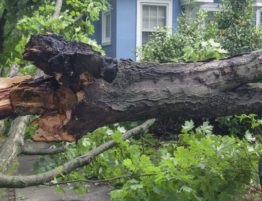
- Personal protective equipment (PPE) is there to ensure your safety for any incident that can occur at your job site.
- Although there are several different pieces of PPE for different areas of work, some common pieces of PPE include hard hats, high-visibility clothing, skin and hand protection, eye protection, hearing protection and more.
- Employers have a responsibility to provide quality protective equipment for their employees and that every employee is trained in the importance of their PPE. However, it’s ultimately the employee’s responsibility to wear it properly.
- When your PPE is not in use, it is recommended to clean it well and store in a dry place to help extend the life of your equipment.
- Make sure your gear fits securely and feels comfortable so that it can be effective on the job site.
Personal protective equipment (PPE) is there to ensure your safety for any incident that can occur at your job site. The type of PPE you need is dependent on your job duties and industry, although there are some common pieces of protective equipment used across the board.
Sometimes wearing PPE may feel like an inconvenience, but we can’t stress enough the importance of wearing every piece of protective equipment at all times—even if the task is short or you’re familiar with the environment. Some of the gear may seem insignificant or less functional, but they all play an important role in keeping you safe and healthy.
Common Pieces of PPE
Although there are several different pieces of PPE for different areas of work, there are a few pieces that are common and used in almost every field. If you’re assigned PPE to wear at work, you’ll probably see:
- Hard hats – Used across several industries for lightweight, durable head protection. This equipment is designed to ensure your head is protected from falling or flying objects, as well as offering electrical protection. The three classifications of hard hats are Class G, E and C.
- Class G—General industry hard hats that are rated for 2,200 volts
- Class E—Electrical hard hats that are rated for 20,000 volts
- Class C—Conductive hard hats that do not offer electrical protection
- High-visibility clothing – Brightly colored vests and hard hats are commonplace in general industry PPE. This helps to ensure everyone is easily seen, keeping you in sight and in mind.
- Skin and hand protection – Hand injuries are all too common for skilled laborers. Some of these cases can be avoided by ensuring that you’re always wearing the proper gloves when handling hazardous materials. In addition to gloves, your workplace may require you to wear durable, long-sleeved clothing. This helps to prevent some superficial injuries, as well as skin diseases such as skin cancer, dermatitis and infections.
- Eye protection – Spectacles, full face shields and safety goggles are a standard component of general industry PPE to help protect your eyes from any outside intrusion.
- Hearing protection – Over 22 million workers are exposed to harmful levels of noise each year. People who ignore hearing protection gear while in noise polluted environments risk long-term auditory loss. Earmuffs or earplugs are ideal to ensure you protect your hearing.
- Safety harnesses – If your workplace requires you to work from heights, you’ll become very familiar with safety harnesses. This helps maintain your position and stability in the event you fall, which helps protect yourself as well as surrounding employees. Make sure the harness is tightly secured at all times.
- Safety footwear – Heavy machinery and falling objects present hazards to your feet if you’re not wearing the proper protection which is why reinforced, non-slip boots are standard in almost every skilled labor industry. This helps protect your feet from being crushed by falling objects while helping maintain your grip on slippery surfaces.
- Respiratory protection – According to OSHA, an estimated 5 million employees are required to wear respiratory protection across over 1 million companies. Your employer is required to provide respiratory protection that’s suitable for the specific task at hand anytime it’s possible to inhale harmful particulates in your workplace. Particulates such as harmful dust, fogs, fumes, mists, gases, smokes, sprays or vapors can be inhaled and have long-term health implications.
PPE Best Practices
Employers have a responsibility to provide quality protective equipment for their employees and that every employee is trained in the importance of their PPE. However, it’s ultimately the employee’s responsibility to wear it properly. You need to be able to discern:
- What type of PPE is necessary and when it’s necessary
- How to adjust, wear, and remove it properly
- The equipment limitations
- Maintenance, proper care, disposal and useful life of the equipment
Additionally, due to different working environment demands, your employer should ensure there is a program that addresses the hazards present and gives key points on the proper use of PPE.
Inspect, Clean and Maintain Your PPE
There are different types of PPE; those that are reusable and varieties that are not. If your personal protective equipment is reusable, you must ensure to give them proper care for the next time they will be required.
When your PPE is not in use, it is recommended to clean it well and store in a dry place to help extend the life of your equipment. Additionally, make sure your gear fits securely and feels comfortable so that it can be effective on the job site.
Personal protective equipment is of utmost importance, as it helps to prevent several common workplace accidents. Therefore, you must ensure that you’re wearing the recommended protective equipment any time you get on site. The rules are there for a reason—following all of your employer’s recommended PPE guidelines helps to ensure your safety at all times.









